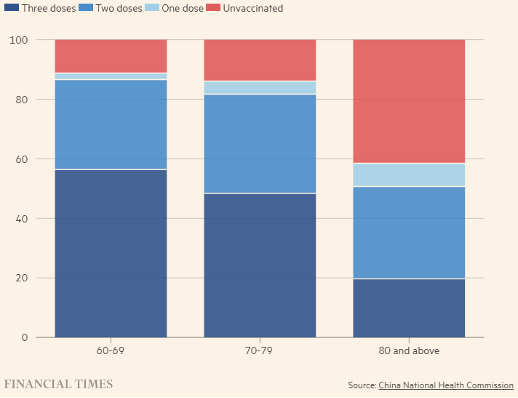As COVID-19 makes a greater impact all over the whole world, many people are wondering how safe they are. Is the virus as destructive as the media says?
The truth is yes, the virus can be destructive. It is particularly destructive in the elderly and also the very young (<1y). There is good news though. The vaccines work.
As many countries around the world vaccinated and then opened-up a little, the virus took hold and spread. New variants emerged and some reports started coming out that maybe the inactivated vaccines were not that good.
Many of these reports did a very short analysis of the situation and averaged all the data. Some of the best data to date, comes from the recent outbreak in Hong Kong. The health officials have been able to break down the data and statistics and show exactly how well each vaccine performed. There were many deaths recently in Hong Kong and this was almost solely in the population of people that were not vaccinated. China mainland has done a great job at vaccinating so many people, and the overall vaccination rate is quite high. However, there are still certain groups of people not yet fully vaccinated. For example, the elderly in China have been much harder to get vaccinated.

For those aged over 60 there is actually a large percentage of unvaccinated, and even more who are yet to complete the full three doses. The last estimate says that only 19.7% of >80 year olds had received all three doses. (http://www.scio.gov.cn/xwfbh/xwbfbh/wqfbh/47673/48041/zy48045/Document/1721930/1721930.htm)
Its important to remember that its essential to get the third booster dose with inactivated vaccines to get optimal protection.
From the deconvoluted data in Hong Kong, the inactivated vaccines have a slightly lower efficacy at preventing infection compared to mRNA vaccines and a slightly lower efficacy at preventing disease. However, three doses of the inactivated vaccines are as good as the mRNA vaccines in preventing death with 0.04047% vs 0.02383% (3x Dose case fatality rate CoronaVac vs Pfizer mRNA). This is compared to 73.9663% (or 6100 people) of all deaths being in completely unvaccinated people in the omicron wave in Hong Kong – with the unvaccinated having an average case fatality rate of 3.8835%. Thus, vaccination with three doses of inactivated vaccine gives you a 95.95997x protection against dying from infection. This number was not adjusted for the number of patients in each group and this protection obviously varies across age, with patients that are 80+ and unvaccinated having a case fatality rate of 15.676% (Source: Centre for Health Protection of the Department of Health, HKSAR).
There’s more good news though, recent reports indicate that two doses and particularly three doses of vaccine, decrease the amount of virus you shed (or spread). So even if you are PCR positive, even if you have mild symptoms, the amount of live, infectious virus you shed is much lower then those infected people that are unvaccinated. So while the virus may not seem as dangerous to younger, healthy people – being vaccinated reduces the chance you will transmit the virus to others. This includes transmission to the susceptible, elderly population.
The data from Hong Kong represents infections with what is known as the “omicron variant”. Its important to remember there are actually different sub-types of Omicron. Initially Hong Kong had a milder strain of omicron called BA.1, though this was gradually replaced with BA.2. The BA.2.2 version of SARS-CoV-2 is what is currently embedded in Shanghai. This virus is indeed milder than some of the other variants such as “Delta” but still potent and at least as lethal as the original strain that tore through Wuhan. Since then, the virus has picked up mutations that increases its speed and infectiousness. Recent estimates of the BA.2.2 variant suggest it could have an R0 of between 12 and 15. This number is based upon estimations of how the virus would spread without treatment/isolation – meaning 1 person could easily infect 12-15 other people. This makes BA.2.2 one of the most infectious viruses ever (just below measles). As this version of the virus spreads we have no idea what variant may emerge next. It may be a milder form, it may be even more lethal. If it gets the opportunity to grow and spread through large unvaccinated populations this increases the chances a new variant could emerge with unpredictable behaviour.
Right now, the best thing we can do, is do your own part. This means take caution. Where masks (N95/KN95 masks are much better than surgical masks), wash your hands, maintain distances where possible and get vaccinated. With a greater proportion of the population vaccinated we have a better chance of our lives getting back to normal. While we wait for the politicians and scientists to discuss the best ways for us to live with the virus, we can maintain our hygiene, get vaccinated, and consider the health of other, more at-risk populations. Those such as the elderly and those with immune-complications preventing vaccination or complicating infection if they become exposed. The creation of new monoclonal antibodies and anti-viral drugs such as paxlovid also offer much better treatment options for those who develop serious disease. The combination of these drugs plus vaccination seems to provide real advantages to those that get serious disease, lowering even further the chance of dying to that similar of other viruses such as influenza. This means there would be much less strain to our healthcare systems and those requiring treatment would have access to it. Combined with better treatment strategies since the initial outbreak and more experience of the relevant doctors, this will hopefully be factored into new strategies for disease management. Lets hope all these factors combined helped us to get back on track!







